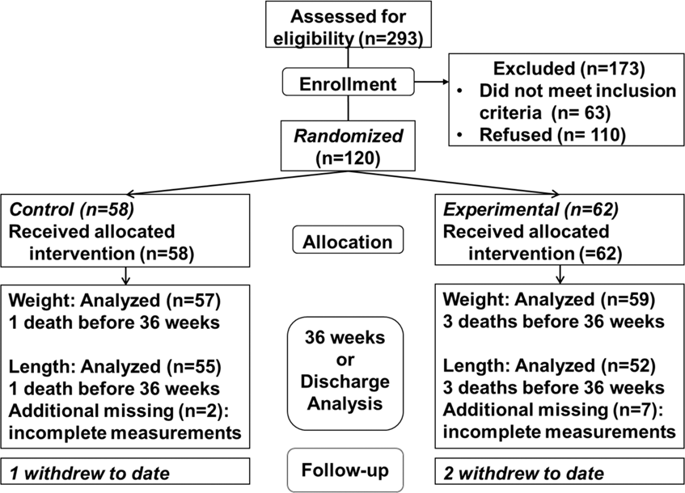Journal of Perinatology ( IF 2.4 ) Pub Date : 2020-02-18 , DOI: 10.1038/s41372-020-0609-1 Luc P Brion 1 , Charles R Rosenfeld 1 , Roy Heyne 1 , L Steven Brown 2 , Cheryl S Lair 2 , Elen Petrosyan 2 , Theresa Jacob 2 , Maria Caraig 1 , Patti J Burchfield 1

|
Objective
In preterm neonates fed human milk, fortification may be adjusted by (1) optimization, based on growth rate and serum nutrient analyses, or (2) individualization, based on serial milk nutrient analyses. The primary aim was to determine whether individualized plus optimized nutrition (experimental) improves velocity of weight gain and linear growth from birth to endpoint (36 weeks postmenstrual age or discharge) when compared with optimized nutrition alone (controls).
Study design
Double-blinded parallel group randomized trial in 120 neonates <29 weeks gestational age (GA) or <35 weeks and small for GA (birth weight < 10th centile).
Result
Weight-gain velocity (13.1 ± 2.1, n = 57 controls, vs. 13.0 ± 2.6 g kg−1 day−1, n = 59 experimental, P = 0.87), linear growth (0.9 ± 0.2, n = 55, vs. 0.9 ± 0.2 cm week−1, n = 52, P = 0.90) and frequency of weight/length disproportion (2% vs. 2%, P = 0.98) were similar in both groups.
Conclusions
Individualized plus optimized nutrition does not improve weight gain, linear growth, or weight/length disproportion at endpoint versus optimized nutrition alone.
中文翻译:

优化早产极低出生体重儿的个体营养:双盲随机对照试验
客观的
在喂食人乳的早产新生儿中,可以通过(1)优化,基于生长速率和血清营养分析,或(2)个体化,基于系列乳营养分析来调整强化。主要目的是确定与单独优化营养(对照)相比,个体化加优化营养(实验)是否能提高体重增加速度和从出生到终点(月经后 36 周或出院)的线性增长。
学习规划
双盲平行组随机试验在 120 名小于 29 周胎龄 (GA) 或 <35 周且 GA 小(出生体重 < 10%)的新生儿中进行。
结果
体重增加速度(13.1 ± 2.1,n = 57 对照,对 13.0 ± 2.6 g kg -1 天-1,n = 59 实验性,P = 0.87),线性增长(0.9 ± 0.2,n = 55,对0.9 ± 0.2 cm 周-1,n = 52,P = 0.90)和体重/长度不成比例的频率(2% 对 2%,P = 0.98)在两组中相似。
结论
与单独优化营养相比,个体化加优化营养并不能改善终点的体重增加、线性生长或体重/长度不均衡。











































 京公网安备 11010802027423号
京公网安备 11010802027423号